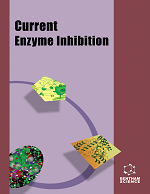- Home
- A-Z Publications
- Current Enzyme Inhibition
- Previous Issues
- Volume 10, Issue 2, 2014
Current Enzyme Inhibition - Volume 10, Issue 2, 2014
Volume 10, Issue 2, 2014
-
-
“PARG Inhibitors’ Success: A Long Way to Go!”
More LessAuthors: Anuradha Pandey, Pooja Makhija, Prakash G. Chandak and Anil B. GaikwadPoly(ADP-ribosyl)ation is one of the most pertinent post translational modifications involved in regulation of chromatin structure, cell cycle progression, tissue development and differentiation and other vital biological phenomena. The enzymes that catalyze the synthesis and degradation of poly(ADP) ribose polymers are PARP and PARG, respectively. The role of PARP has been implicated in development of various diseases Read More
-
-
-
Shape Complementarity in Serine Protease-inhibitor Complexes Correlate to Inhibition Constants
More LessAuthors: Lunminlal Kipgen and Kamal K. AggarwalNatural proteinaceous protease inhibitors inhibit through nonproductive binding to proteases and steric blockage of active sites. These complexes are among the most structurally complementary protein-protein interactions. To see if complementarity is correlated to activity, we scored the shape complementarity in 15 serine protease-inhibitor complexes through in silico docking and compared the scores against their repor Read More
-
-
-
Structure Assessment Analysis of Core Domain of Seven Protein Data Bank Entries of HIV-1 Protease Using Different in-silico Techniques
More LessAuthors: Mymoona Akhter, Kalicharan Sharma, M. M. Alam, M. S. Zaman, A. Husain, Shakir Ali and Shah A. KhanDespite the explosion in structural biologythe multi-dimensional complexity of the structure determination process of biomolecules like proteins significantly poses hindrances to drug development and study of interaction of ligands to the target. Since virtual screening has come up as a potential tool in the process of drug discovery the availability of macromolecular structures has limitations. Moreover, when more than Read More
-
-
-
Virtual Screening Against M. tuberculosis 7,8-Diaminopelargonic Acid Synthase (MtbBioA) and In Silico Toxicity Evaluation of Top Hits
More LessTuberculosis (TB) remains to be one of the major public health concerns worldwide. The continuing emergence of Mtb strains resistant to known drugs makes the campaign for successful TB control and treatment very difficult to accomplish. It is therefore imperative to search for newer chemical entities that could inhibit the growing number of putative drug targets for the development of more efficient anti-tubercular dr Read More
-
-
-
Screening of Two Algerian Spontaneous Plants for Anti-lipase and Antioxidant Activities
More LessLipase inhibitors have a high pharmacological interest because they could help in the therapy of diseases in which lipases play an important role such as obesity. Extracts from two Algerian spontaneous plants: Oudneya africana and Pulicaria crispa, were screened for potential lipase inhibitory activity. The enzymatic inhibition produced by these plants extracts is described here for the first time. Additionally, the antioxidant activi Read More
-
-
-
Inhibition of Candida rugosa Lipase by Different Extracts of Five Algerian Plants and their Antioxidant Activities
More LessAuthors: Madjda Benguechoua, Samira Nia, Khedidja Benarous, Ihcen Khachba and Mohammed YousfiLipase inhibitors are drugs used to reduce the activity of lipase found in the intestine. These inhibitors are used for the treatment of obesity and cardiovascular diseases. The purpose of this work was to explore in vitro the enzymatic and antioxidant activities of secondary metabolites extracts such as, phenolic compounds, flavonoids and tannins obtained with various extraction solvent systems: methanol/water, acetone/water Read More
-
-
-
In-vitro Studies on α-Amylase, α-Glucosidase and Aldose Reductase Inhibitors found in Endophytic Fungi Isolated from Ocimum sanctum
More LessEighty four endophytic fungi were isolated from Ocimum sanctum. Secondary metabolites extracted from these endophytic fungi were tested for the inhibitors of enzymes responsible for the glycaemic index and polyol pathway. Six isolates were positive for both α-glucosidase and α-amylase inhibitors. Secondary metabolites from four endophytic fungal isolates inhibited aldose reductase enzyme extracted from rat lens. Crud Read More
-
-
-
Inhibition of NADPH: Quinone Oxidoreductase Activity of Camel Lens ζ-Crystallin by Colchicine
More LessColchicine is a toxic alkaloid known for its therapeutic applications. In addition to the inhibition of microtubule polymerization, colchicine has been reported to inhibit many key enzymes. Here we provide evidence for colchicine binding and inhibiting ζ-crystallin purified from camel eye lens. Indeed, we demonstrated the molecular interaction between colchicine and ζ-crystallin using fluorescence quenching. Moreover, colchic Read More
-
-
-
Dextransucrase from Weissella cibaria JAG8 Inhibited by Lysine and Cysteine Specific Inhibitors
More LessAuthors: T.J.M. Rao and Arun GoyalDextransucrase isolated from Weissella cibaria JAG8 was subjected to active site mapping analysis by using lysine specific inhibitor viz. pyridoxal-5’-phosphate (PLP) and 2,4,6-trinitrobenzenesulphonic acid (TNBS) gave 98.5% and 98.7% inhibition in enzyme activity at 25 mM concentration respectively. The -NH2 lysine derivative of enzymeinhibitor complex with PLP and TNBS gave absorbance maxima at 325 and 369 nm, re Read More
-
Volumes & issues
-
Volume 20 (2024)
-
Volume 19 (2023)
-
Volume 18 (2022)
-
Volume 17 (2021)
-
Volume 16 (2020)
-
Volume 15 (2019)
-
Volume 14 (2018)
-
Volume 13 (2017)
-
Volume 12 (2016)
-
Volume 11 (2015)
-
Volume 10 (2014)
-
Volume 9 (2013)
-
Volume 8 (2012)
-
Volume 7 (2011)
-
Volume 6 (2010)
-
Volume 5 (2009)
-
Volume 4 (2008)
-
Volume 3 (2007)
-
Volume 2 (2006)
-
Volume 1 (2005)
Most Read This Month
Article
content/journals/cei
Journal
10
5
false
en


